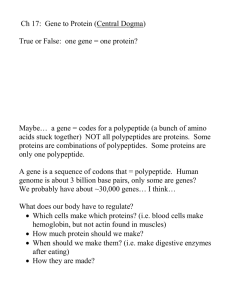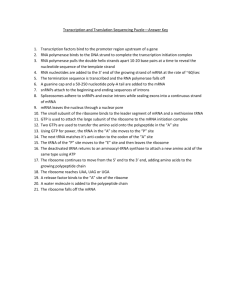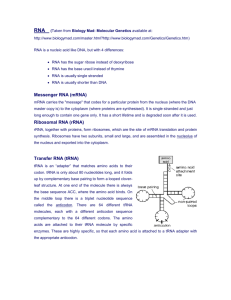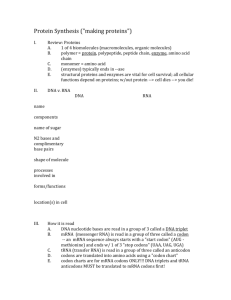Study Questions for Chapter 17: From Gene to Protein
advertisement
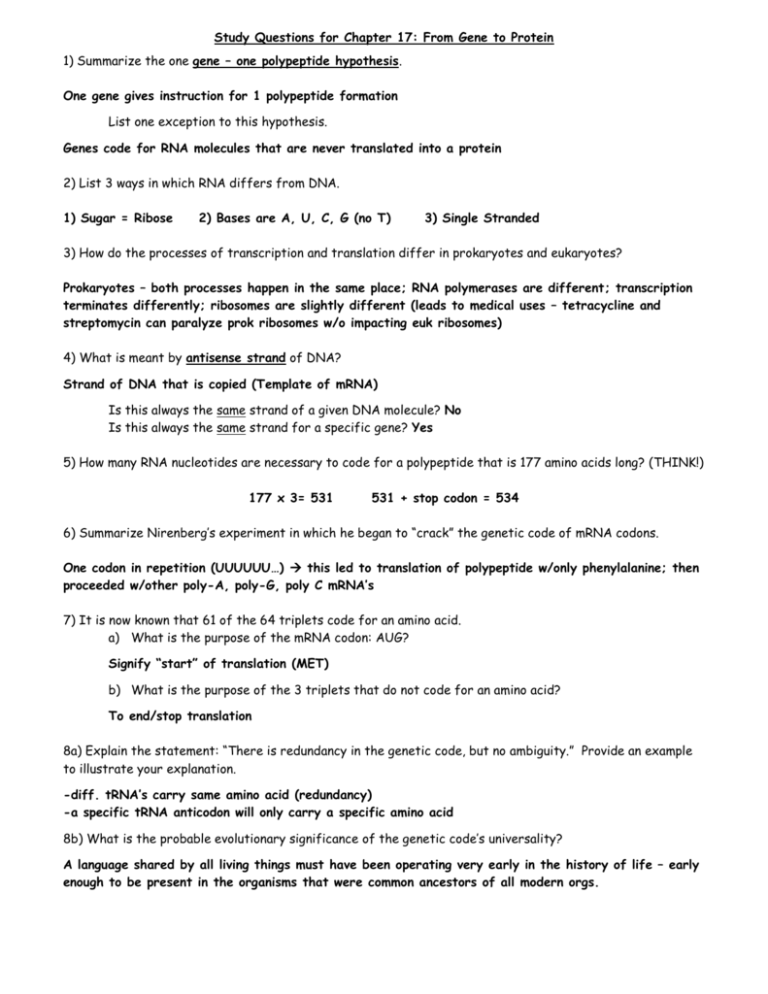
Study Questions for Chapter 17: From Gene to Protein 1) Summarize the one gene – one polypeptide hypothesis. One gene gives instruction for 1 polypeptide formation List one exception to this hypothesis. Genes code for RNA molecules that are never translated into a protein 2) List 3 ways in which RNA differs from DNA. 1) Sugar = Ribose 2) Bases are A, U, C, G (no T) 3) Single Stranded 3) How do the processes of transcription and translation differ in prokaryotes and eukaryotes? Prokaryotes – both processes happen in the same place; RNA polymerases are different; transcription terminates differently; ribosomes are slightly different (leads to medical uses – tetracycline and streptomycin can paralyze prok ribosomes w/o impacting euk ribosomes) 4) What is meant by antisense strand of DNA? Strand of DNA that is copied (Template of mRNA) Is this always the same strand of a given DNA molecule? No Is this always the same strand for a specific gene? Yes 5) How many RNA nucleotides are necessary to code for a polypeptide that is 177 amino acids long? (THINK!) 177 x 3= 531 531 + stop codon = 534 6) Summarize Nirenberg’s experiment in which he began to “crack” the genetic code of mRNA codons. One codon in repetition (UUUUUU…) this led to translation of polypeptide w/only phenylalanine; then proceeded w/other poly-A, poly-G, poly C mRNA’s 7) It is now known that 61 of the 64 triplets code for an amino acid. a) What is the purpose of the mRNA codon: AUG? Signify “start” of translation (MET) b) What is the purpose of the 3 triplets that do not code for an amino acid? To end/stop translation 8a) Explain the statement: “There is redundancy in the genetic code, but no ambiguity.” Provide an example to illustrate your explanation. -diff. tRNA’s carry same amino acid (redundancy) -a specific tRNA anticodon will only carry a specific amino acid 8b) What is the probable evolutionary significance of the genetic code’s universality? A language shared by all living things must have been operating very early in the history of life – early enough to be present in the organisms that were common ancestors of all modern orgs. 9) List two functions of the DNA region known as the promoter and one function of the DNA sequence known as the terminator. Promoter: 1) determines which of the 2 strands of the double helix are used as the template 2) determine where transcription starts Terminator: (seq. of DNA) functions as a termination signal 10) Complete the chart below summarizing the changes made to a pre-mRNA molecule in eukaryotes. mRNA end Description of Function #1 Function #2 modification 5’ end Modified (G) Cap Protect mRNA from “attach” here sign for degradation ribosomes 3’ end Poly-A tail Protect mRNA from Helps mRNA leave the 30-200 (A) nucleotides degradation nucleus 11) What is RNA splicing? Why is this done? RNA splicing takes out sections of mRNA that are not coding for a section of the protein; introns are spliced out and exons are then joined together to make a continuous coding sequence 12) Introns (non-coding regions) were once thought to be “junk DNA” but now it is thought that they do have biological and/or evolutionary importance. List 3 potential functions of introns. 1. Increase opportunity for crossing over between 2 alleles of a gene; raises probability that a crossover will switch one version of an exon for another version on homolog. chromos. 2. Regulatory role in the cell 3. Splicing process may regulate passage of mRNA from nucleus to cytoplasm 13) Sketch and label a typical ribosome. Include its protein and RNA composition, large & small subunits, three tRNA binding sites, and mRNA binding site. P mRNA binding site 14) Summarize the role in protein synthesis of each of the enzymes/proteins/structures listed in the chart below. Enzyme/protein/structure RNA polymerase Function in protein synthesis Unwind and open DNA; hook new nucleotides into RNA chain Aminoacyl-tRNA synthetase Join correct amino acid to correct tRNA Initiation factors Proteins that bring together mRNA, initiator tRNA, small ribosomal subunit and large ribosomal subunit Elongation factors Proteins that help add amino acids one by one to the 1 st amino acid Release factors Protein that binds directly to the stop codon in the A site; causes addition of H2O instead of an amino acid Ribosomal sites: *A site A site: holds tRNA carrying the next amino acid to be added P site: holds tRNA carrying the growing polypeptide E site: exit sit for empty tRNA *P site *E site 15) What is the purpose of polyribosomes? When several ribosomes work on a single mRNA to make several copies of a protein 16) Describe 3 ways in which a polypeptide may be modified after translation has occurred. 1) Certain amino acids may be chemically modified (attach lipids, sugars…) 2) Enzyme excises part of chain to become active 3) 2 or more separate polypeptides joined (Hb) 17a) Ribosomes can either be “free” or “bound.” Discuss the destination of the final protein product from each of these. Free – function in cytosol Bound – make protein or endomembrane system and secreted from cell (insulin) 17b) How does a “free” ribosome become a “bound” ribosome? Sequence of 20 amino acids at or near beginning of polypeptide; recognized as it emerges from ribosome by SRP (protein-RNA complex); brings ribosome to receptor built into ER membrane 18) Complete the following table for the functions of the various types of RNA in a eukaryotic cell. Type of RNA Messenger RNA (mRNA) Function Copy message of DNA gene and take message to ribosome Transfer RNA (tRNA) Translate message of nucleic acid (mRNA) into correct amino acid order Ribosomal RNA (rRNA) Provide site for mRNA and tRNA to temporarily H-bond; aligning amino acids Small nuclear RNA (snRNA) RNA that works with proteins as part of the spliceosome SRP RNA Recognizes if emerging polypeptide should go to ER; brings protein there w/ribosome snoRNA Aids in processing of pre rRNA transcript for ribosome subunit formation in the nucleolus siRNA and miRNA Involved in regulation of gene expression (which get expressed) 19) What is a ribozyme? RNA molecule that functions like an enzyme and catalyzes reactions during RNA splicing 20) What is the significance of polar and nonpolar amino acids? (Not from the text… think!) IB Things to Know: State 4 functions of proteins, giving a named example of each (do not include membrane proteins). Fibrous vs globular proteins with 2 examples of each o Fibrous: insoluble; elongated molecules in which the secondary structure (either alpha-helices or betapleated sheets) forms the dominant structure (keratin, silk, collagen) o Globular: highly diverse group of proteins that are soluble and form compact spheroidal molecules in water; all have tertiary structure and some have quaternary structure (enzymes, myoglobin)



